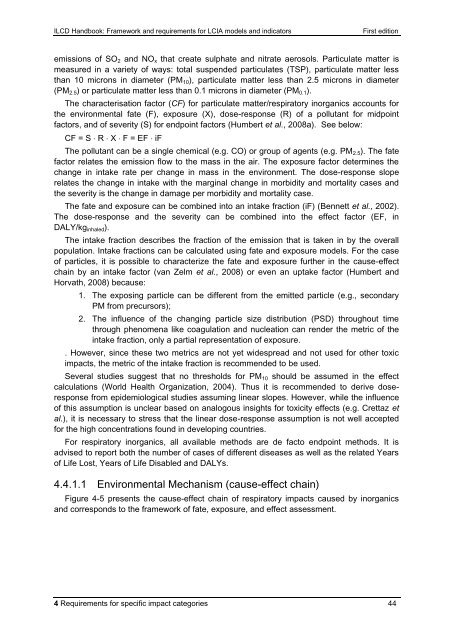ILCD Handbook: Framework and requirements for LCIA models and ...
ILCD Handbook: Framework and requirements for LCIA models and ...
ILCD Handbook: Framework and requirements for LCIA models and ...
Create successful ePaper yourself
Turn your PDF publications into a flip-book with our unique Google optimized e-Paper software.
<strong>ILCD</strong> <strong>H<strong>and</strong>book</strong>: <strong>Framework</strong> <strong>and</strong> <strong>requirements</strong> <strong>for</strong> <strong>LCIA</strong> <strong>models</strong> <strong>and</strong> indicators First edition<br />
emissions of SO2 <strong>and</strong> NOx that create sulphate <strong>and</strong> nitrate aerosols. Particulate matter is<br />
measured in a variety of ways: total suspended particulates (TSP), particulate matter less<br />
than 10 microns in diameter (PM10), particulate matter less than 2.5 microns in diameter<br />
(PM2.5) or particulate matter less than 0.1 microns in diameter (PM0.1).<br />
The characterisation factor (CF) <strong>for</strong> particulate matter/respiratory inorganics accounts <strong>for</strong><br />
the environmental fate (F), exposure (X), dose-response (R) of a pollutant <strong>for</strong> midpoint<br />
factors, <strong>and</strong> of severity (S) <strong>for</strong> endpoint factors (Humbert et al., 2008a). See below:<br />
CF = S R X F = EF iF<br />
The pollutant can be a single chemical (e.g. CO) or group of agents (e.g. PM2.5). The fate<br />
factor relates the emission flow to the mass in the air. The exposure factor determines the<br />
change in intake rate per change in mass in the environment. The dose-response slope<br />
relates the change in intake with the marginal change in morbidity <strong>and</strong> mortality cases <strong>and</strong><br />
the severity is the change in damage per morbidity <strong>and</strong> mortality case.<br />
The fate <strong>and</strong> exposure can be combined into an intake fraction (iF) (Bennett et al., 2002).<br />
The dose-response <strong>and</strong> the severity can be combined into the effect factor (EF, in<br />
DALY/kginhaled).<br />
The intake fraction describes the fraction of the emission that is taken in by the overall<br />
population. Intake fractions can be calculated using fate <strong>and</strong> exposure <strong>models</strong>. For the case<br />
of particles, it is possible to characterize the fate <strong>and</strong> exposure further in the cause-effect<br />
chain by an intake factor (van Zelm et al., 2008) or even an uptake factor (Humbert <strong>and</strong><br />
Horvath, 2008) because:<br />
1. The exposing particle can be different from the emitted particle (e.g., secondary<br />
PM from precursors);<br />
2. The influence of the changing particle size distribution (PSD) throughout time<br />
through phenomena like coagulation <strong>and</strong> nucleation can render the metric of the<br />
intake fraction, only a partial representation of exposure.<br />
. However, since these two metrics are not yet widespread <strong>and</strong> not used <strong>for</strong> other toxic<br />
impacts, the metric of the intake fraction is recommended to be used.<br />
Several studies suggest that no thresholds <strong>for</strong> PM10 should be assumed in the effect<br />
calculations (World Health Organization, 2004). Thus it is recommended to derive doseresponse<br />
from epidemiological studies assuming linear slopes. However, while the influence<br />
of this assumption is unclear based on analogous insights <strong>for</strong> toxicity effects (e.g. Crettaz et<br />
al.), it is necessary to stress that the linear dose-response assumption is not well accepted<br />
<strong>for</strong> the high concentrations found in developing countries.<br />
For respiratory inorganics, all available methods are de facto endpoint methods. It is<br />
advised to report both the number of cases of different diseases as well as the related Years<br />
of Life Lost, Years of Life Disabled <strong>and</strong> DALYs.<br />
4.4.1.1 Environmental Mechanism (cause-effect chain)<br />
Figure 4-5 presents the cause-effect chain of respiratory impacts caused by inorganics<br />
<strong>and</strong> corresponds to the framework of fate, exposure, <strong>and</strong> effect assessment.<br />
4 Requirements <strong>for</strong> specific impact categories 44



